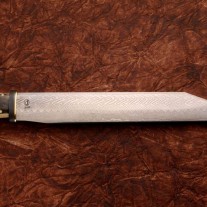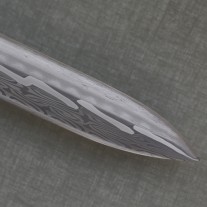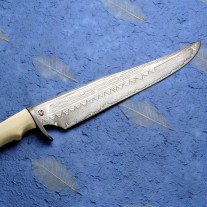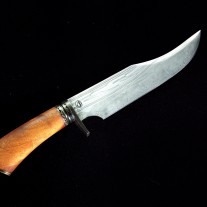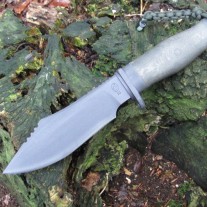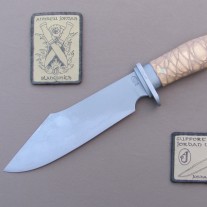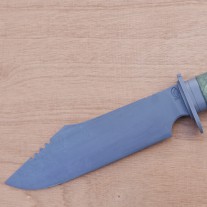Saex (42 cm)
Single edged sword from the Viking period. This is complex pattern welding of different bars of material forged together to become one Saex. The patterns had names: Boudica, Ann, Odin's lightning, Adderback, 'mow'. The cutting edge is a sandwich of bloom steel (same as tamahagane) flanked by wrought iron (folded).
Pattern welding has a long history in Europe going back to the Celtic period. When iron was first made it had a lot of sulfur in it and was made into bars as a currency. A warrior would get bars and take them to a smith and ask him to forge a blade from the material. A sword in the Celtic period was a very prestigious object for a warrior. Being a soft steel it was of course much more durable then bronze but still had the tendency of bending. The smith solved this problem by learning that if you twist the iron it would become much more rigid. This twist combined with different types of iron bar created a visible pattern. This patterning was developed over a thousand years to a high art form.
During the early Middle Ages (formerly Dark Ages) in England from 3rd century to 1066 pattern welding was continually worked on by the smiths to create weapons, spearheads and saexes of an ever increasing difficulty.
In mainland Europe there were smiths working in the Merovingian and Carolingian cultures too. Smiths vied against each other to create more and more complex patterns.
It is understood there were names for the patterns: Boudica, Ann, Odin's lightning, Adderback, 'mow'. Boudica means water eddy, but what this means as a spiritual image and what this appertains too in the woven pattern made by the Norns we do not know. It has been eradicated from the records by the Christians. There are some hints about what these patterns meant in the Edda (Viking sagas) but unfortunately we are unable to really clearly understand the meanings. But is is clear that the patterns in sword, spearheads and Saexes made by these gifted smiths had great importance in the early medieval culture and society.
For more info read my article
"The code in the Sword" in
The Sacred Hoop.
